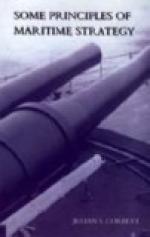The whole campaign serves well to show what was understood by concentration at the end of the great naval wars. To Lord Barham and the able admirals who interpreted his plans it meant the possibility of massing at the right time and place. It meant, in close analogy to strategic deployment on land, the disposal of squadrons about a strategical centre from which fleets could condense for massed action in any required direction, and upon which they could fall back when unduly pressed. In this case the ultimate centre was the narrows of the Channel, where Napoleon’s army lay ready to cross, but there was no massing there. So crude a distribution would have meant a purely defensive attitude. It would have meant waiting to be struck instead of seeking to strike, and such an attitude was arch-heresy to our old masters of war.
So far we have only considered concentration as applied to wars in which we have a preponderance of naval force, but the principles are at least equally valid when a coalition places us in inferiority. The leading case is the home campaign of 1782. It was strictly on defensive lines. Our information was that France and Spain intended to end the war with a great combined effort against our West Indian islands, and particularly Jamaica. It was recognised that the way to meet the threat was to concentrate for offensive action in the Caribbean Sea everything that was not absolutely needed for home defence. Instead, therefore, of trying to be strong enough to attempt the offensive in both areas, it was decided to make sure of the area that was most critical. To do this the home fleet had to be reduced so low relatively to what the enemy had in European waters that offence was out of the question.




